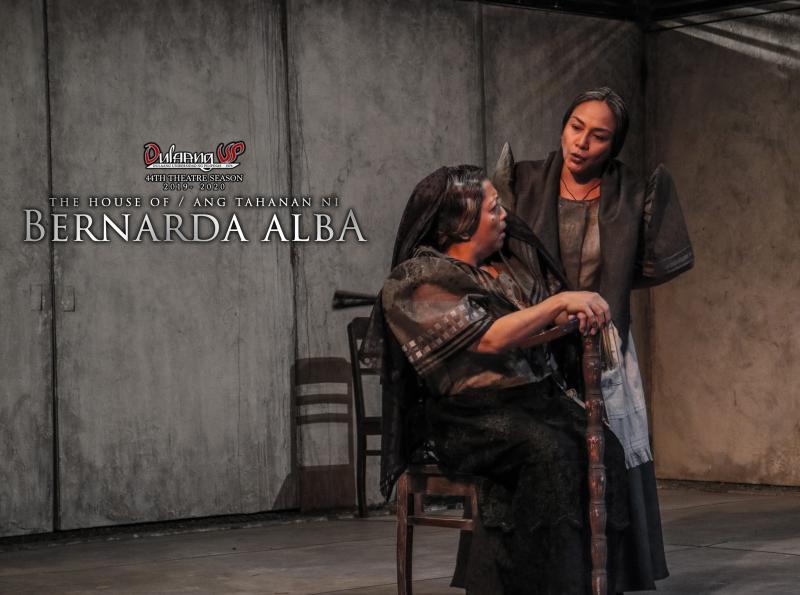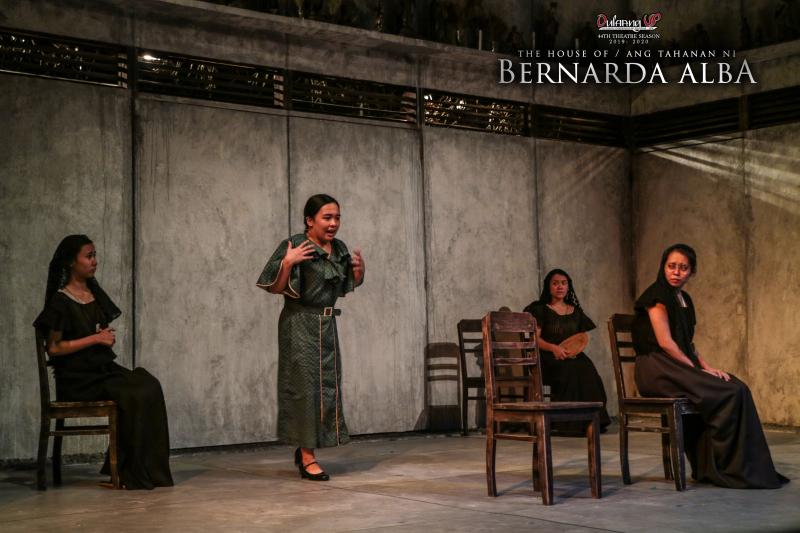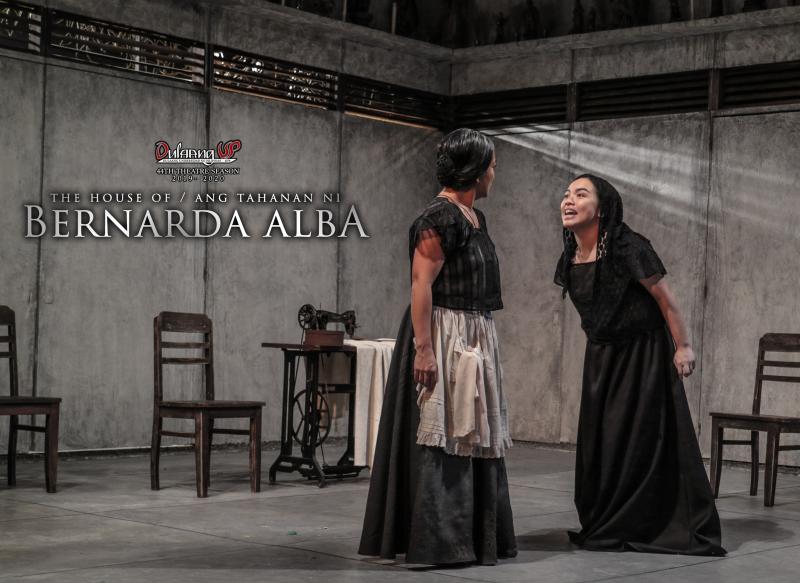Review: Repression, Passion and Resistance During Mourning Season in THE HOUSE OF BERNARDA ALBA
![]()
 There are brief moments in the first act that make it difficult to hold your interest in the play, but the second act is much more fast-paced. As secrets are slowly revealed, the audience gets more involved in the story.
There are brief moments in the first act that make it difficult to hold your interest in the play, but the second act is much more fast-paced. As secrets are slowly revealed, the audience gets more involved in the story.
Manila, Philippines - Although Federico Garcia Lorca's La Casa de Bernarda Alba was written way back in 1945, Dulaang UP's staging is certainly worth watching. The original Spanish text was translated into English by Daisy Lopez (The House of Bernarda Alba) and into Filipino by Alexander Cortez (Ang Tahanan ni Bernarda Alba), who is also the director of the play. It starts with the mourning of the death of Bernarda Alba's husband, which brings everyone in the family to eight years of mourning. With this mourning period in effect, tension builds in the household and Bernarda's five daughters: Angustias, Magdalena, Amelia, Martirio, and Adela are even more on the edge as they are forbidden to engage in any sort of relationship.
The play builds up slowly, never leading the audience on more than what is necessary. As the scenes unfold, we witness just how much abuse the daughters endure. They aren't the only victims of Bernarda Alba's tyranny though, as she also takes it upon herself to control her mother and their servants. There isn't so much as a single step in the house that she wouldn't know about, she says, and yet so much goes on inside the household which she has completely no control over. She doesn't care about anything bad that happens; she cares only if the neighbors find out about it.
Frances Makil-Ignacio is incredibly commanding as Bernarda Alba, drawing the audience's eyes to her on her every scene as if she could command the audience as well. She speaks with the utmost authority and embodies the stern and oppressive matriarch image. As the puppet master in her house, Bernarda Alba tries to remain in charge even when things are progressing more than what she can control, and Makil-Ignacio shows the nuances of her character as she tries to sweep issues under the rug but cannot successfully do so anymore.
 Poncia, the housekeeper, is yet another powerful character in the play, one who undeniably knows more about what is happening in the household more than anyone else like an omniscient figure. Stella Cañete Mendoza delivers a precise performance and slips into her role effortlessly. With her being able to talk frankly to Bernarda Alba and connecting deeper to the five daughters, it sometimes seems she is just as (if not more) powerful than the matriarch herself. Even from the beginning of the play, she immediately had her hold on the attention of the audience and was able to consistently keep it on her.
Poncia, the housekeeper, is yet another powerful character in the play, one who undeniably knows more about what is happening in the household more than anyone else like an omniscient figure. Stella Cañete Mendoza delivers a precise performance and slips into her role effortlessly. With her being able to talk frankly to Bernarda Alba and connecting deeper to the five daughters, it sometimes seems she is just as (if not more) powerful than the matriarch herself. Even from the beginning of the play, she immediately had her hold on the attention of the audience and was able to consistently keep it on her.
There are brief moments in the first act that make it difficult to hold your interest in the play, but the second act is much more fast-paced. As secrets are slowly revealed, the audience gets more involved in the story and are at the edge of their seats waiting to know how it will all develop. Love is always a timeless theme and so when conflict arises over a man, it feels as if it's just yet another story of jealousy and sibling rivalry. But what makes The House of Bernarda Alba different is the way Director Alexander Cortez manages the build-up of the tension and revelations up to the chilling ending.
Among the five daughters, Sarina Sasaki shines through as Martirio. She is very expressive with her subtle looks and reactions that even though the attention would initially be on Adela and Angustias, the audience will be looking forward to seeing what she does next. She never holds back in committing to her character and effectively shows Martirio's strength as she struggles with everything that is unfolding around her.
Bernarda Alba's youngest daughter is the most free-spirited of them all, having the most courage to rebel against her mother. Pauline Maxine Ignacio is striking as Adela, capturing her unbridled youth and relentless desire. Adela as a character does tend to become a bit aggravating, and perhaps the audience would have felt more sympathy for her when she pays the price of her rebellion had Pauline's build-up of going mad over her love been more sure-footed and steady, not in bursts. In essence, Adela becomes the true madwoman of the household, not Maria Josefa.
 The scene of Adela and Martirio's confrontation is one of the most memorable parts of the play as they both finally reach their tipping point. There is no turning back from what has been said and done, and the whole ordeal is intense and notable because Sarina and Pauline pull off a very skillful performance of their respective roles. Their back-and-forth is impressive and is not disappointing as the penultimate scene.
The scene of Adela and Martirio's confrontation is one of the most memorable parts of the play as they both finally reach their tipping point. There is no turning back from what has been said and done, and the whole ordeal is intense and notable because Sarina and Pauline pull off a very skillful performance of their respective roles. Their back-and-forth is impressive and is not disappointing as the penultimate scene.
Though Maria Josefa's lines are brief, they are very important. Rica Nepomuceno's performance ensures that the audience is hanging on to her every word and listening intently. Also in the cast are Opaline Santos as Angustias, Gel Basa as Magdelena, Camille Abaya as Amelia, and Jacqui Amper as Servant, who truly shows there is no small role in a play. They are essential in bringing the whole story together and establishing its important themes to today's audience.
The production design by Gino Gonzales is effective in bringing the audience to the setting of suffocating house of Bernarda Alba. The design of the whole set is meaningful down to every detail. It fully comes alive with the lighting design by D. Cortezano. It is impossible to not notice how each scene is brilliantly lit. The light behind the doors and the windows, the silhouettes they create, and the mood that is set for the tense scenes are all very commendable. The sounds (Jethro Joaquin) and music (Katz Trangco) are also good although sometimes they do not fully complement the scene, which may be sound limitations from the theater itself rather than bad choices.
While the themes of oppression and tyranny and the image of a modern-day dictator are evident in The House of Bernarda Alba, it needs to set a good tone as Dulaang UP's 44th season opener but it falls a bit short. With a theme such as "Daluhong," the Filipino word for "assault," the theater group intends to bring attention to the prevalent societal issues by staging plays that show the need to strengthen the resistance against the injustice, but the message of a call to action is not as clear in the play as they had hoped. However, it does encourage audiences to look forward to the next plays in their season line-up.
Photos: Dulaang UP
Reader Reviews
Videos

